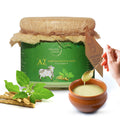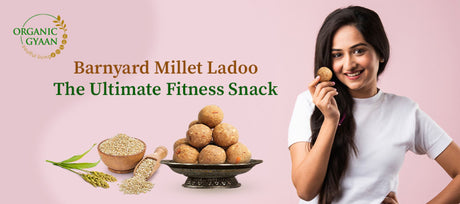
Millet Rajma Salad: A Power-Packed Dish for Modern Healthy Living
By Organic Gyaan
Looking for a wholesome, plant-based meal? Try Millet Rajma Salad—a high-protein, low-GI, fiber-rich recipe perfect for diabetes, weight loss, and energy.
Read more



Little millet, also known as Samai, is a powerhouse of nutrition, known for its role in balancing hormones, supporting digestion, and being the perfect first solid food for babies. With 10x more fiber than rice, it helps regulate blood sugar, improve gut health, and strengthen the body from within. Being the smallest millet grain, it is light, easy to digest, and packed with essential minerals—making it ideal for all ages, from infants to adults dealing with hormonal imbalances.
These little millet benefits make it a valuable addition to a hormone-balancing and digestive health-focused diet.
Whether for daily nourishment or specific healing needs, the diverse little millet uses make it a must-have in your kitchen.
Little millet is versatile and easy to cook, making it a great rice alternative in daily meals.
Best for: Porridge, dosa, idli, kheer, upma & khichdi.
Soaking Tip: Soak for 6–8 hours before cooking for better nutrient absorption.
Water Ratio for Cooking:
These simple steps ensure that the nutritional value of unpolished little millet is preserved during preparation.
Fermenting little millet enhances its probiotic properties, making it even more powerful for digestion, gut healing, and hormonal regulation.
How to Ferment Cooked Little Millet
This traditional practice further improves organic little millet’s benefits, especially in daily detox and wellness routines.
Dr. Khadar Sir’s Recommended Millet Routine for Hormonal Balance
Following this cycle for 4–6 months helps regulate hormones & restore balance naturally through the healing power of samai and other positive millets.
Buying little millet online in small, fresh batches helps retain maximum flavor and nutrient density, especially when you choose organic little millet.
Balance your hormones naturally & nourish your little one’s health with the easiest-to-digest millet. Try little millet today and feel the difference!
1. What is little millet/samai millet?
Little millet/samai millet is a small-seeded millet grain that is commonly grown in India and parts of Asia for human consumption and as animal feed.
2. What are the nutritional benefits of little millets/samai millet?
Little millets/samai millets are rich in fiber, protein, vitamins, minerals, and antioxidants. It also has a low glycemic index, making it a good choice for people with diabetes.
3. Can little millet/samai millet be used in place of rice or other grains?
Yes, little millet/samai millet can be used in place of rice or other grains in most recipes, including porridge, pulao, and upma.
4. Is little millet/samai millet gluten-free?
Yes, little millet/samai millet is naturally gluten-free and can be consumed safely by individuals with celiac disease or gluten intolerance.
5. How should little millet/samai millet be stored?
Little millet/samai millet should be stored in an airtight container in a cool, dry place to preserve its freshness and quality. It can be stored for up to 6 months.
6. What is the taste of little millet/samai millet like?
Little millet/samai millet has a mild, slightly nutty flavor that can complement a variety of dishes and seasonings.
7. Can we eat little millet/samai millet during fasting?
Yes, little millet/samai millet is typically allowed during fasting, but always check your fasting guidelines for specific dietary restrictions.
8. little millet/samai millet for babies?
Little millet/samai millet is a nutritious choice for babies. It's rich in fiber and nutrients, but consult a pediatrician for age-appropriate introduction.
Note: As with any food, moderation is key and it is important to vary your baby's diet to ensure they are receiving a balanced mix of nutrients.
 Best Quality Guaranteed
Best Quality Guaranteed Free from Chemical & Pesticides | NO GMO
Free from Chemical & Pesticides | NO GMO
 Best Quality Guaranteed
Best Quality Guaranteed Free from Chemical & Pesticides | NO GMO
Free from Chemical & Pesticides | NO GMO
 Best Quality Guaranteed
Best Quality Guaranteed Free from Chemical & Pesticides | NO GMO
Free from Chemical & Pesticides | NO GMO
 Best Quality Guaranteed
Best Quality Guaranteed Free from Chemical & Pesticides | NO GMO
Free from Chemical & Pesticides | NO GMO
 Best Quality Guaranteed
Best Quality Guaranteed Free from Chemical & Pesticides | NO GMO
Free from Chemical & Pesticides | NO GMO
 Best Quality Guaranteed
Best Quality Guaranteed Free from Chemical & Pesticides | NO GMO
Free from Chemical & Pesticides | NO GMO
 Best Quality Guaranteed
Best Quality Guaranteed Free from Chemical & Pesticides | NO GMO
Free from Chemical & Pesticides | NO GMO
 Best Quality Guaranteed
Best Quality Guaranteed Free from Chemical & Pesticides | NO GMO
Free from Chemical & Pesticides | NO GMO
 Best Quality Guaranteed
Best Quality Guaranteed Free from Chemical & Pesticides | NO GMO
Free from Chemical & Pesticides | NO GMO
 Best Quality Guaranteed
Best Quality Guaranteed Free from Chemical & Pesticides | NO GMO
Free from Chemical & Pesticides | NO GMO
 Best Quality Guaranteed
Best Quality Guaranteed Free from Chemical & Pesticides | NO GMO
Free from Chemical & Pesticides | NO GMO
 Best Quality Guaranteed
Best Quality Guaranteed Free from Chemical & Pesticides | NO GMO
Free from Chemical & Pesticides | NO GMO
 Best Quality Guaranteed
Best Quality Guaranteed Free from Chemical & Pesticides | NO GMO
Free from Chemical & Pesticides | NO GMO
 Best Quality Guaranteed
Best Quality Guaranteed Free from Chemical & Pesticides | NO GMO
Free from Chemical & Pesticides | NO GMO
 Best Quality Guaranteed
Best Quality Guaranteed Free from Chemical & Pesticides | NO GMO
Free from Chemical & Pesticides | NO GMO
 Best Quality Guaranteed
Best Quality Guaranteed Free from Chemical & Pesticides | NO GMO
Free from Chemical & Pesticides | NO GMO
 Best Quality Guaranteed
Best Quality Guaranteed Free from Chemical & Pesticides | NO GMO
Free from Chemical & Pesticides | NO GMO
 Best Quality Guaranteed
Best Quality Guaranteed Free from Chemical & Pesticides | NO GMO
Free from Chemical & Pesticides | NO GMO
 Best Quality Guaranteed
Best Quality Guaranteed Free from Chemical & Pesticides | NO GMO
Free from Chemical & Pesticides | NO GMO
 Best Quality Guaranteed
Best Quality Guaranteed Free from Chemical & Pesticides | NO GMO
Free from Chemical & Pesticides | NO GMO

By Organic Gyaan
Looking for a wholesome, plant-based meal? Try Millet Rajma Salad—a high-protein, low-GI, fiber-rich recipe perfect for diabetes, weight loss, and energy.
Read more
By Organic Gyaan
Millet pongal is the ultimate comfort food—wholesome, gut-friendly, and perfect for weight loss, diabetes, and daily nourishment. A smart, tasty swap!
Read more
By Organic Gyaan
Brown Top Millet Ladoo is a nutritious and delicious snack that combines the goodness of brown top millet with the richness of traditional Indian sweets.
Read more
By Organic Gyaan
The Ragi Oats Ladoo, a harmonious blend of these two ingredients, emerges as a perfect snack for people looking to manage their blood sugar levels effectively.
Read more
By Organic Gyaan
Did you know a tiny, ancient grain could be a game-changer in your workout routine? Say hello to Barnyard Millet, a super nutritious grain that's making a big comeback in...
Read more
By Organic Gyaan
In the realm of weight management and healthy eating, it's easy to get lost in a sea of trendy diets and superfoods.
Read more
By Organic Gyaan
More and more people are choosing gluten-free diets for better health. Among many gluten-free options, Kodo millet is very nutritious and good for health.
Read more
By Organic Gyaan
Diving into the world of millets introduces you to a realm of culinary possibilities that combine health, nutrition, and taste in every bite.
Read moreWe currently ship to the United States, Canada, Australia and the UK. To enquire about shipping to a different destination, please contact us.
Standard shipping normally takes 3-5 days. Next day shipping is available on all domestic orders (for an additional charge). International shipping times depend on the products and destination (estimated at checkout).
Items must be returned within 30 days after receiving your order. Items must be returned in the same condition in which they were received, be unworn/unused, have any tags still attached, and include all the original packaging.
Refunds are processed within 7 days from when we receive the item(s).





Little millet, also known as Samai, is a powerhouse of nutrition, known for its role in balancing hormones, supporting digestion, and being the perfect first solid food for babies. With 10x more fiber than rice, it helps regulate blood sugar, improve gut health, and strengthen the body from within. Being the smallest millet grain, it is light, easy to digest, and packed with essential minerals—making it ideal for all ages, from infants to adults dealing with hormonal imbalances.
These little millet benefits make it a valuable addition to a hormone-balancing and digestive health-focused diet.
Whether for daily nourishment or specific healing needs, the diverse little millet uses make it a must-have in your kitchen.
Little millet is versatile and easy to cook, making it a great rice alternative in daily meals.
Best for: Porridge, dosa, idli, kheer, upma & khichdi.
Soaking Tip: Soak for 6–8 hours before cooking for better nutrient absorption.
Water Ratio for Cooking:
These simple steps ensure that the nutritional value of unpolished little millet is preserved during preparation.
Fermenting little millet enhances its probiotic properties, making it even more powerful for digestion, gut healing, and hormonal regulation.
How to Ferment Cooked Little Millet
This traditional practice further improves organic little millet’s benefits, especially in daily detox and wellness routines.
Dr. Khadar Sir’s Recommended Millet Routine for Hormonal Balance
Following this cycle for 4–6 months helps regulate hormones & restore balance naturally through the healing power of samai and other positive millets.
Buying little millet online in small, fresh batches helps retain maximum flavor and nutrient density, especially when you choose organic little millet.
Balance your hormones naturally & nourish your little one’s health with the easiest-to-digest millet. Try little millet today and feel the difference!
1. What is little millet/samai millet?
Little millet/samai millet is a small-seeded millet grain that is commonly grown in India and parts of Asia for human consumption and as animal feed.
2. What are the nutritional benefits of little millets/samai millet?
Little millets/samai millets are rich in fiber, protein, vitamins, minerals, and antioxidants. It also has a low glycemic index, making it a good choice for people with diabetes.
3. Can little millet/samai millet be used in place of rice or other grains?
Yes, little millet/samai millet can be used in place of rice or other grains in most recipes, including porridge, pulao, and upma.
4. Is little millet/samai millet gluten-free?
Yes, little millet/samai millet is naturally gluten-free and can be consumed safely by individuals with celiac disease or gluten intolerance.
5. How should little millet/samai millet be stored?
Little millet/samai millet should be stored in an airtight container in a cool, dry place to preserve its freshness and quality. It can be stored for up to 6 months.
6. What is the taste of little millet/samai millet like?
Little millet/samai millet has a mild, slightly nutty flavor that can complement a variety of dishes and seasonings.
7. Can we eat little millet/samai millet during fasting?
Yes, little millet/samai millet is typically allowed during fasting, but always check your fasting guidelines for specific dietary restrictions.
8. little millet/samai millet for babies?
Little millet/samai millet is a nutritious choice for babies. It's rich in fiber and nutrients, but consult a pediatrician for age-appropriate introduction.
Note: As with any food, moderation is key and it is important to vary your baby's diet to ensure they are receiving a balanced mix of nutrients.
Weight
HIGH NUTRITIONAL VALUE
Organic foods preserve far more vitamins & minerals
NO CHEMICALS & PESTICIDES
We don’t use artificial fertilisers or additives in our food
CERTIFIED ORGANIC SOURCES
Our products quality is verified by top certification bodies
PRESERVES THE ENVIRONMENT
Sustainable farming ensures soil conversation & reduced air pollution